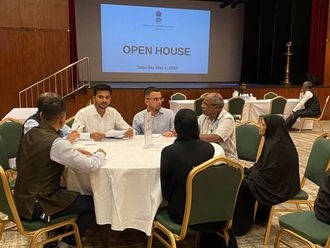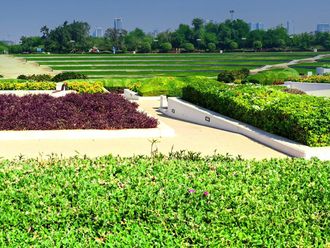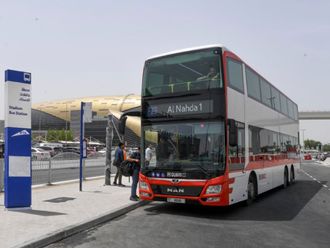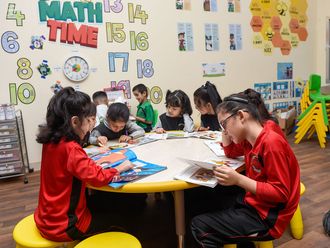A team of earthquake experts is calling for a study to evaluate quake risks to the UAE and the vulnerabilty of the country's buildings.
They point to the proximity of the UAE to potential earthquake faults - the nearest being just 100 kilometres away - and warn that no research has been done to evaluate how vulnerable buildings here would be to a major tremor.
A research programme called "Earthquake Risk Assessment and Vulnerability of Structures in the UAE" has been proposed by the team led by Dr Azm S. Al Homoud, Professor of Civil Engineering at the American University of Sharjah (AUS). Other members of the team are Jamal A. Abdullah and Abdel Tamimi, Assistant Professors at the Engineering College of the AUS.
"The effect of seisms in structures, the degree of damage they may cause and the evaluation of risk and vulnerability can be assessed accurately only if appropriate knowledge about earthquake hazards, building types, dynamic properties and responses of soil-building systems to earthquakes of various magnitudes are well studied and researched," they say.
They noted that research into the vulnerability of buildings in the UAE to earthquakes has never been done. In an exclusive interview with Gulf News, Dr Al Homoud said, "Though the Arabian peninsula, including the UAE, is absolutely free from specific sources of earthquake, it is very near sources of earthquakes as there are major faults to the east of the Gulf."
"The nearest is about 100 kilometres away from the nearest UAE city or offshore structure," he added. Al Homoud stressed that a national action plan to deal with such natural disasters should be prepared in the light of the proposed research, as he expects another major seismic action in the eastern side of the Gulf in the next 10 to 20 years.
"Such a major source of earthquake to the east of the UAE, such a short distance away, may result in low to moderate ground shaking in areas in and around the country," he said.
Al Homoud said that the UAE is adjacent to the Iranian plateau, which is characterised by very high density of active and recent faults. "The Iranian plateau is one of the most seismically active areas of the world and frequently suffers destructive and catastrophic earthquakes that cause heavy loss of human life and widespread damage.
"The seismic risk in the UAE is due to the very active neighbouring Iranian seismic region. Given the dynamic UAE national development, including major on-land and off-shore infrastructure developments, it is considered important to assess the seismic risk and vulnerability of the UAE and develop sound mitigation strategies.
"Currently, there is no UAE national earthquake code, nor any earthquake mitigation strategies whatsoever. Moreover, researchers are not aware of any past or on-going studies in this regard.
"In addition, there is a rapid increase in the number, height and size of commercial and residential buildings, schools and highway bridges in Sharjah and Dubai metropolitan areas, and the researchers suspect that most of these structures have been designed and constructed without compliance with earthquake codes.
Al Homoud asserted that there was an immediate need to conduct a study to assess the seismic risk and vulnerability of buildings in the UAE based on the buildings' damage potential. This, he said, would help plan for construction of earthquake resistant facilities, assess the societal and economical impact of disastrous earthquakes, develop emergency plans for the aftermath, and take all the precautions needed to mitigate earthquake hazards.
The proposed research is structured in four independent but co-ordinated and complementary phases. The first phase deals with the pilot investigation of prehistorical earthquakes: Sharjah and Dubai regions. The second project covers the measurements and simulation of strong ground motion for regional seismic hazard assessment in the UAE. The third is Microzonation and Local Site Effects: Sharjah and Dubai regions; and the fourth phase will deal with risk scenarios and vulnerability assessment of Sharjah and Dubai.
He said that through this comprehensive research project, they could help the government develop an action plan to cope with natural calamities such as earthquake. "Such efforts will reduce the scale of damage and risk due to earthquakes as the authorities can make their contingency plans to cope with the situation."
He noted that preparedness and planning to cope with the aftermath of an earthquake was the most important factor to be taken into account as lack of awareness and poor rescue operation was the major cause of deaths.
"Public awareness campaigns should be launched and students should be taught how to react. Rescue teams should be trained for such specific rescue operations, especially in the high risk areas, although we don't see any immediate threat of earthquake in the region," he suggested. Jamal A. Abdalla urged the need to design and construct earthquake-resistant buildings that withstand moderate and severe earthquakes.
Experts urge study on UAE earthquake risk
A team of earthquake experts is calling for a study to evaluate quake risks to the UAE and the vulnerabilty of the country's buildings.










